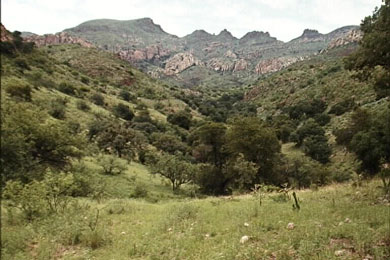
| Issue 1, Winter 2003 | ||||
Tumacacori and Atacosa Highlands
AWC Proposed Acreage: 77,200 Acres
Wilderness QualitiesThe topography of the area is a mosaic of rolling hills and deep draws cut by many steep, rough canyons. Vegetation is not dense, but presents a pleasing pattern of golden grasses dotted liberally with green oaks and chaparral species. The visitor experiences a mild climate and a colorful, spacious terrain of endless rolling hills and valleys. There is only one major hiking trail at the southern boundary near Ruby Road and Atascosa Peak. As a result, the opportunity for solitude is considerable. Because of the large size of this unit, visitors can easily escape the sights and sounds of civilization by hiking from canyon to canyon. Looking west from any of the numerous peaks, visitors take in unobstructed, natural views for hundreds of miles. There are no developed recreational sites or established camping areas in this roadless area. Ecological ValuesThe fascinating species found in the Tumacacori Mountains originate in the sub-tropic ranges to the south. While yellow-billed cuckoos, elegant trogons, Mexican spotted owls, and gray hawks may be sighted on any given day, perhaps most noteworthy is the plant diversity in these mountains. The Chiltepin, the rare native variety of most chiles now produced, is known to occur in its highest densities here. The Forest Service has dedicated a special zoological and botanical area to protect this plant from over-harvesting. Wilderness designation would complement and strengthen the protection of this important plant and provide lasting protection for the multitudes of other rare and sensitive plant species occurring here. This area offers fertile wildlife habitat, especially for white-tailed deer and javelina. Not surprisingly, mountain lion, black bear, bobcat, and the occasional jaguar also reside in these mountains. Because of the large acreage here, wilderness designation will be an important step in preserving the roaming habitat of these native mammals. Canyons and drainages such as Peck, Ramanote, Walker, Fresno, and Cedar contain precious riparian strips of velvet ash, Bonpland’s and desert willow, Arizona black walnut, Fremont cottonwood, and netleaf hackberry among others. The endangered Chiricahua leopard frog occurs in Ramanote Canyon and a smaller tributary, Lion Canyon. Recreational ValuesThe Tumacacori – Atascosa Highlands are prized for their rich diversity of birds and attract bird-watchers from all over the country. Opportunities for photography, hiking, exploring, horse-packing, and nature watching abound. Hunting is also a popular activity in the Tumacacori and Atacosa Highlands. Wilderness designation would protect and enhance these recreational values. Several boundary adjustments have been made on the northeast corner to allow continued motorized access for hunters and others. Cedar, Peck, and Pine Canyon riparian areas and Atascosa ridge are considered to be special ecological and geological features of the area, according to the U.S. Forest Service. The scenic value of the highlands is also rated at the top of the scale by the agency. Recreational use is limited mainly to the southern portion along Ruby Road. Many hunters, hikers, and naturalists use this area. The majority of the unit, however, is relatively unvisited. ThreatsAs the Santa Cruz River Valley quickly becomes developed for vacation homes, high-density housing, and industrial uses, the Tumacacoris are threatened by overuse and fragmentation. Already along Ruby Road, new roads are being created illegally on a monthly basis. As the Tumacacori Highlands—with the rest of the Coronado Forest—become more recreationally dominated, wilderness designation will help to disperse impacts and protect the values that attract forest users. Many illegal roads are created from repeated Border Patrol use, with little regard for existing federal laws restricting all motorized vehicles to signed routes. Perhaps most notably, a proposal to install a high-voltage powerline directly through the heart of this roadless area looms in a planning stage today. With wilderness designation, we can ensure that this area will be conserved in its natural, beautiful, and vibrant state for future generations. ContactIf you’d like to learn more about this potential wilderness area or how you can get involved in protecting it and advocating for it’s designation, contact Matt Scroch, Sky Islands Regional Coordinator, at (520) 624-7080, or matt@skyislandalliance.org.
|
||||


 Make your late winter and early spring outdoor plans here! Visit our comprehensive list of day outings, inventory trips, meetings, and upcoming AWC events for the latest in wilderness “happenings” around the state.
Make your late winter and early spring outdoor plans here! Visit our comprehensive list of day outings, inventory trips, meetings, and upcoming AWC events for the latest in wilderness “happenings” around the state. 
